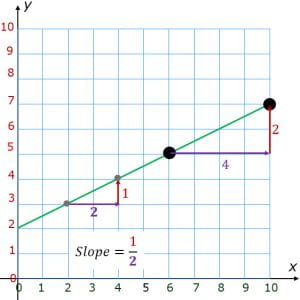The slope of a line is a measure of its steepness. Slope is the rate of change between any two points on a line.
Slope compares the vertical change to the horizontal change when moving from one fixed point to another along the line.
Types of Slopes:
Slope is typically represented by the letter m.
In Mathematics, the slope of a line is defined as the change in y-values divided by the change in x-values.
If given 2 points on a line, you may find the slope using the formula:
The greater the slope, the steeper the line goes upward.
- Lines that travel up from left to right have positive slopes.
- Lines that travel down from left to right have negative slopes.
- A horizontal line does not go up or down, (y2 – y1 = 0).
Dividing zero by any number will give us a zero, so the slope is 0. - The horizontal line has a slope of zero because its height never changes.
- A vertical line does not run horizontally (x2 – x1 = 0).
Since it is impossible to divide by 0, the slope of a vertical line is undefined.
To find the slope of a line, find the ratio of the change in y to the change in x .
Parallel lines have the same slope.
Real life example:
The ADA [Americans with Disabilities Act] recommends 1 foot for ramp for every one inch of rise. The ramp must have no more than a 1:12 ratio.
Videos:
Slope
Slope from a Table
Slope 3
Graphing with Slope Intercept
Drills:




